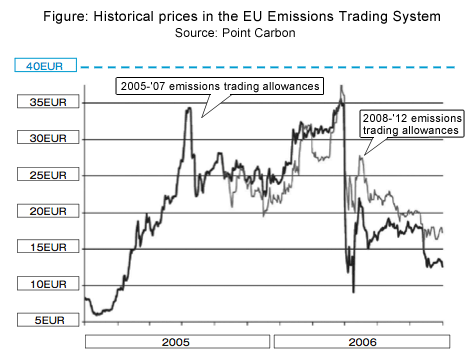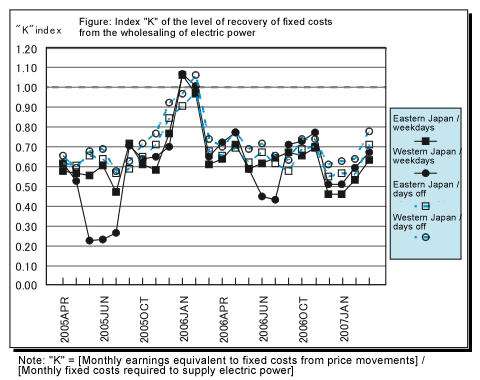From discretionary administration to market monitoring
The deregulatory trend in recent years has given rise to the issue of shifting from a system of adjustment by means of discretionary approval by the administrative authorities to a system of adjustment that uses the market mechanism, even with regard to the supply-demand situation for goods and services with a strongly public-service character. The superiority of the market for short-term supply-demand adjustments is self-evident.
But even long-term issues will be adjusted by a mechanism in which the market provides price indexes and the firms concerned make autonomous investment judgements, such as private capital investment plans of the kind subject to long-term infrastructure investment under the system of discretionary approval by the administrative authorities. However, with regard to supply-demand adjustments for goods and services with a strongly public-service character, does the market in its present state function effectively as a long-term indicator? If not, what can be done about it?
EU Emissions Trading System: Despite failure to form an index of investment, were there lessons to be learned?
A measure to counter global climate change is being implemented in the EU in the form of the laying-down of targets for parts of the industrial sector and initial allocations of CO2 emission allowances, and the granting of permission to trade the allowances. As the first phase of this measure, trading in emission allowances was conducted under a system applied from 2005-2007, but the price of emission allowances soared to just under €40, the level of the penalty for each excess ton, and then slumped suddenly to €15 following the April 2006 announcement of details of the actual supply-demand statistics. The reason for this extreme market volatility was that market participants predicted that initial allocations of emission allowances would be very severe, and so the price was raised. But since the actual initial allocations had been realistic in view of international competitiveness, the release of the actual supply-demand statistics caused a deviation between the two to appear suddenly.

With regard to the relationship between these results and long-term investment, both government and industry have officially observed that there were problems with the system. The European Commission has announced that, given the large fluctuation in the price of emission allowances, the market at present does not give sufficient incentive for investment, while the business community has commented that the allocation period has been too short and the method of future allocation has not been made clear, limiting the impact on promoting investment and rendering it impossible to make long-term management judgements. In anticipation of the third phase, the EC has learnt from this experience and will be revising its measures (Reference 1). That is to say, because the opacity of the system caused the "needle" at the core of the EU emissions trading system index to swing excessively, it did not serve as an index.
The Japan Electric Power Exchange: Investment index formed, but it was effectively zero
In Japan, a series of regulatory reforms affecting the electric power system has liberalized most trading in industrial electric power, and the Japan Electric Power Exchange (JEPX) was established to facilitate the wholesaling of electric power since 2005. At the recommendation of the Advisory Committee for Natural Resources and Energy, the exchange was established as a private-sector voluntary market, but its objectives were to provide a means of procuring wholesale electric power and of forming investment index prices.
I constructed a model for the optimal composition of power sources with regard to the relationship between investment and historical price movements on the exchange, based on the financial statements of electric utilities and the customs-clearance prices of various fuels. Upon analyzing this I estimated that - with the exception of the winter period in fiscal 2005, when there was severe winter weather and heavy snowfalls - at prevailing prices the utilities have been able to recover only approximately 65% of the fixed costs of power stations being operated to meet demand.
The reason for this is that, to encourage new market entrants, incumbent electric utilities are urged by the regulator to take measures to provide electricity retailers with low prices through their bilateral contract systems. As a result, correct price formation did not take place because trading on JPEX was circumvented through the use of those bilateral systems (Reference 2). That is to say, because of problems with the alternative system that was developed with the objective of stimulating competition, that "needle" at the core of the index as seen from an investment perspective was effectively at zero.

For a market-type system to function as an index of investment, the authorities must rebuild the capabilities of their human resources
The two examples above show that simply leaving it up to the market to adjust the supply-demand situation for goods and services with a strongly public-service character does not necessarily allow an index to be formed, and thus that it is essential to implement measures such as constant market monitoring and the redesign of the system for dealing with problems that arise. The role of government agencies and other authorities in a market-type system is by no means eliminated; what it entails is the changing and restructuring of meaning and content of their roles. So it is essential that, together with this changing and restructuring, the human-resource capabilities of the authorities need to be rebuilt to adapt them for governance characterized by market monitoring and redesigning the market system.
At first sight there may not appear to be a connection, but I also feel that the frequent occurrence of bid-rigging and other scandals of government agencies and other authorities in recent years has not simply been a question of ethics, but signifies a failure in rebuilding these human capabilities.


